An unusually strong solar storm hitting Earth could produce northern lights in the U.S. this weekend and potentially disrupt power and communications. The National Oceanic and Atmospheric Administration issued a severe geomagnetic storm warning when a solar outburst reached Earth on Friday afternoon, earlier than expected. The effects were due to last through the weekend and possibly into the next week. Operators of power plants and spacecraft in orbit, as well as the Federal Emergency Management Agency, were alerted to take precautions. While most people won’t have to do anything, the storm could produce northern lights as far south as Alabama and Northern California.
Experts stressed that the northern lights seen as a result of the solar storm would not be the dramatic curtains of color normally associated with the phenomenon. Instead, they would appear as splashes of greenish hues. The best views of the aurora may be captured with phone cameras, which are better at capturing light than the naked eye. The most intense solar storm in recorded history occurred in 1859 and prompted auroras in central America and possibly even Hawaii. While this storm is not anticipated to be as extreme, rated a 4 on a scale of 1 to 5, it poses a risk for high-voltage transmission lines for power grids and could affect satellites, disrupting navigation and communication services on Earth.
The sun has been producing strong solar flares since Wednesday, resulting in at least seven outbursts of plasma. Each eruption, or coronal mass ejection, can contain billions of tons of plasma and magnetic field from the sun’s outer atmosphere. This solar activity is part of the ramping up of the sun as it approaches the peak of its 11-year cycle. The storm, rated a 4 on a scale of 1 to 5, poses a risk for high-voltage transmission lines for power grids, not the electrical lines found in people’s homes, and could also affect satellites, disrupting navigation and communication services. An extreme geomagnetic storm in 2003 temporarily took out power in Sweden and damaged power transformers in South Africa.
While NASA stated that the storm poses no serious threat to the seven astronauts aboard the International Space Station, increased radiation levels could be a concern. The crew could move to a better shielded part of the station if necessary. Increased radiation levels could also pose a danger to some of NASA’s science satellites, prompting extremely sensitive instruments to be turned off if necessary to avoid damage. Several sun-focused spacecraft are monitoring the solar activity to study and understand the effects of the storm. Overall, while the solar storm is expected to produce northern lights in the U.S., precautions are being taken to mitigate any potential disruptions to power grids, satellites, and communication services.


